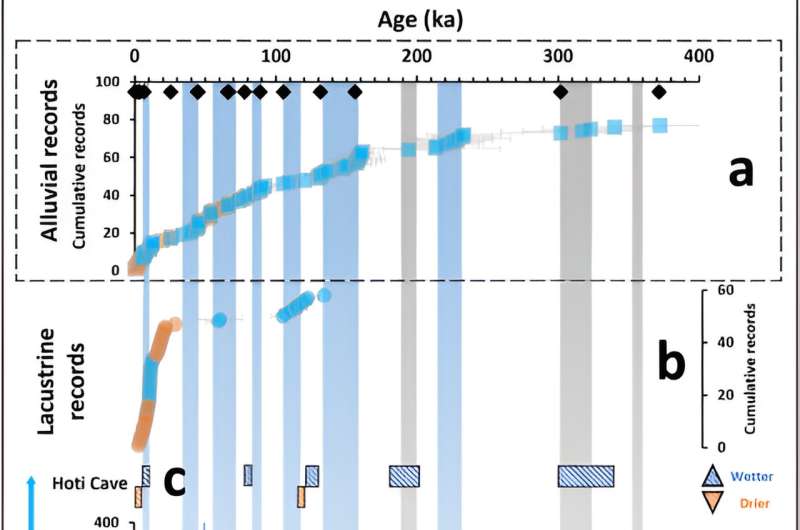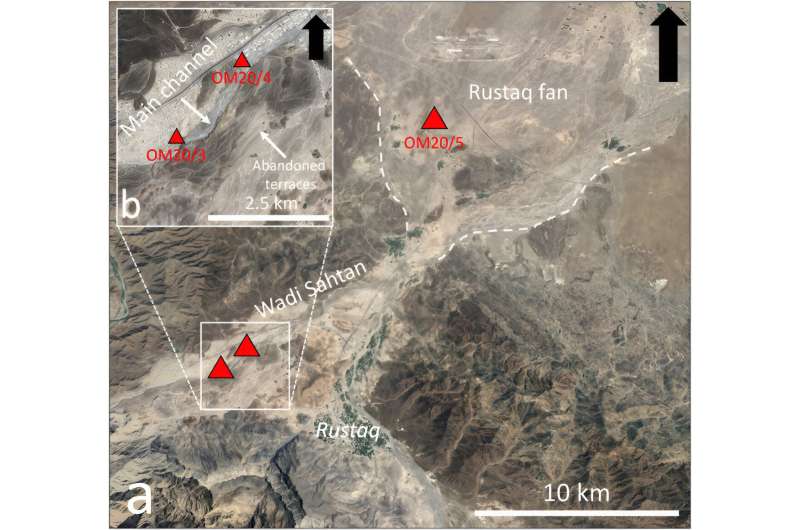
Erosion of Earth’s topography entrains sediment in rivers flowing across mountains, canyons and other naturally steep landscapes within the catchment. This silt, sand and gravel is transported variably by suspension in the water column, bouncing along the river bed (saltation), or rolling larger pebbles (traction). With a deceleration in water velocity, and therefore carrying capacity, as topography flattens, this material is deposited in a fan shape at the mouth of the river on the shallower plain of the break in slope, becoming progressively finer-grained with distance from the source.
Monsoons, seasonal climate phenomena that cause extreme wet and dry conditions, can impact the development of alluvial fans by increasing the volume and velocity of water for both catchment erosion and sediment transport, therefore supporting the development of larger alluvial fans. This aggradation has been linked to forcings from Earth’s orbital cycles in new research published in Quaternary Science Reviews.
Dr. Sam Woor, from the University of Oxford, and colleagues investigated alluvial fans in the arid Hajar mountains of south-east Arabia, ranging from 0.01 km2 to 10,000 km2 and dated to the Mid-Late Quaternary (up to ~770,000 years ago). Specifically, the scientists aimed to determine alluvial fan sedimentation links to monsoon rainfall patterns affected by geological timescales of ~23,000 years (precession, the “wobble” of Earth’s axis) and ~100,000 years (eccentricity, the change between circular and elliptical orbits).
The research team collected samples from eight sites across mountain-front fans (bajadas) and valley infills, including the channel of Wadi Sahtan near Rustaq, Oman, where river incision exposes 20 m deep fluvial sediments of silt up to large pebbles, as well as alluvial fans near Dhank and Ibri, both also in Oman, which extend onto the expansive foreland basin and coalesce.

In the laboratory, the samples were treated with acids to remove carbonates and organic material before medium-coarse quartz grains were isolated for use in a technique known as optically stimulated luminescence. This process relies upon the radioactive signal of elements in the crystal (such as uranium, thorium and potassium) accumulating once the quartz is buried and removed from exposure to sunlight.
The radioactivity causes electrons to migrate within the quartz crystals and become trapped in the structure. When the crystals are exposed to stimulated light in the laboratory, the scientists can measure the light they emit back and estimate the number of trapped electrons, and therefore the amount of radiation it has been exposed to, thus determining the ages of alluvial aggradation. Importantly, the scientists had to keep their samples away from exposure to sunlight both during collection and in the laboratory so as not to reset this signal, involving working under orange light conditions.
Dr. Woor and colleagues determined a connection between grain size and climate patterns, with coarse conglomerates of rock fragments embedded in a finer matrix forming thick floodplain deposits typical of high rainfall events during the Indian Ocean Summer Monsoon. These were found to coincide with precessional maxima, causing seasonal contrasts to be more extreme in one hemisphere compared to the other.
Conversely, alluvial fan samples taken from times of ephemeral flow with fine silt-sand, laminations and bioturbation from organisms coincided with precessional minima. Sustained hydrological activity was identified in 10 periods across the last 400,000 years, each of which broadly coincided with precession and eccentricity peaks.
The oldest site (OM20/6) in the sample area was dated to 300,000–370,000 years ago, with silty paleosols (ancient soils) indicating seasonal flooding on a floodplain that is interspersed with conglomerates forming braided streams during high flow events. This coincides with an interglacial period in the northern hemisphere, as well as records from speleothems (characteristic cave formations formed from groundwater mineral deposits) in Hoti Cave, Oman, which evidence enhanced rainfall.
At ~156,000 years ago, site OM20/12 preserved a conglomerate deposited from high-energy fluvial flow and records fan aggradation. The next phases of alluvial fan aggradation are recorded at ~132,000, ~105,000, ~89,000, ~67,000, ~45,000, ~25,000, ~7,000 and ~2,000 years ago (with a mean relative uncertainty of ±10,700 years). The scientists therefore suggest that arid conditions between Indian Ocean Summer Monsoon events are when physical weathering of the landscape takes place, subsequently being mobilized by heavy rainfall during the climate events and depositing coarser-grained sediments in ever-growing alluvial fans.
In addition to the above precessional cycle, interglacial periods on 100,000 year cycles would have increased sea surface temperature and therefore the abundance of water vapor in the atmosphere evaporating from the Indian Ocean, increasing precipitation further. The overprinting of these two orbital cycles seemingly had a much greater impact on Earth’s climate, with drainage networks being incredibly sensitive to even small increases in rainfall.
This research offers an important insight into climate variability of an arid region during the Quaternary, and reveals that much larger factors are at play to impact local environmental conditions.
More information:
Sam Woor et al, The aggradation of alluvial fans in response to monsoon variability over the last 400 ka in the Hajar Mountains, south-east Arabia, Quaternary Science Reviews (2023). DOI: 10.1016/j.quascirev.2023.108384
© 2023 Science X Network
Citation:
Arabia’s alluvial fans grow and decay with Earth’s orbital cycles (2023, December 27)
retrieved 28 December 2023
from https://phys.org/news/2023-12-arabia-alluvial-fans-decay-earth.html
This document is subject to copyright. Apart from any fair dealing for the purpose of private study or research, no
part may be reproduced without the written permission. The content is provided for information purposes only.

